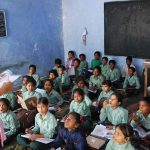 Ensuring all children are in school is the first step towards ensuring quality of education. However, India is home to the largest number of out of school children in Asia and second highest in the world.
Ensuring all children are in school is the first step towards ensuring quality of education. However, India is home to the largest number of out of school children in Asia and second highest in the world.
Estimates of the exact numbers vary, ranging from 226 lakh in the National Sample Survey (2009-10) to 381 lakh in Census 2011 and 60 lakh according to MHRD.
Even greater numbers of out of school adolescents exist. Concrete plans need to be put in place to ensure that these children are not deprived of educational opportunities.
The Right to Education Act, 2009 (RTE) provides for all governments to provide ‘special training’ for out-of-school children and puts the onus on them to mainstream them into formal schooling system at age-appropriate level.
State governments are responsible for planning, designing and implementation of programmes to bring out of school children into school and ensure age appropriate admission.
Unfortunately, comprehensive national analysis of implementation of accelerated learning provision is missing. We undertook a study on the implementation of this provision for Accelerated Learning in four states which provides some indication on how these are implemented. Standalone studies for accelerated programmes in other states also exist.
While most states have guidelines for implementation of special training, these have frequently not reached the district level and have not formed the basis of orientation of concerned officials. Clear delineation of the roles and responsibilities to specific officials has also not been done resulting in poor roll out.
There is also no consistency in terms of the qualifications and working conditions of teachers providing special training leading to poor quality of teaching.
Poorly qualified teachers frequently fail to understand and transact subject content and are unable to address psycho-social needs of out of school children.
Poor salaries have been found to lead to high levels of attrition among teachers. In all four states studied by us, special training teachers were not satisfied with training provided to them.
Teaching dropouts and never enrolled children is a difficult task and calls for the hiring of the best teachers, which is almost never done. Monitoring mechanisms of these centres have also varied.
This calls for exploring new and different approaches to ensuring that India’s youth is educated and no one is left behind through innovative methods. In order to achieve this, the content should be flexible, curriculum, materials and pedagogy accelerated, gender sensitive and inclusive and promote empowerment and psychosocial well-being.
Special training should be undertaken in inclusive and safe learning environments by teachers who are adequately qualified, supervised and remunerated, and who receive adequate opportunities for continuous professional development. The centres must be effectively managed and run in close tandem with the community.
Behind patchy delivery of special training is limited fund flow from the government. Recent budgetary analyses, like a recent study undertaken by CBGA, point towards high disparities between approved allocations and actual expenditure on mainstreaming out of school children.




